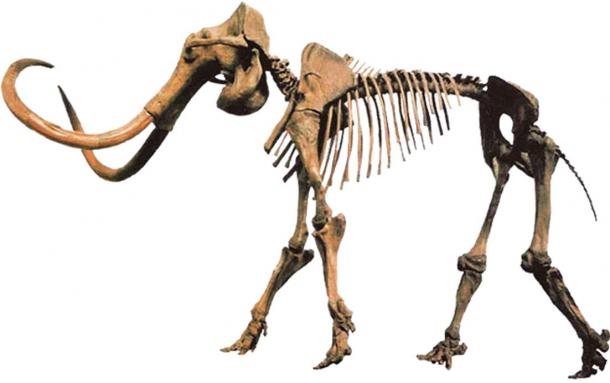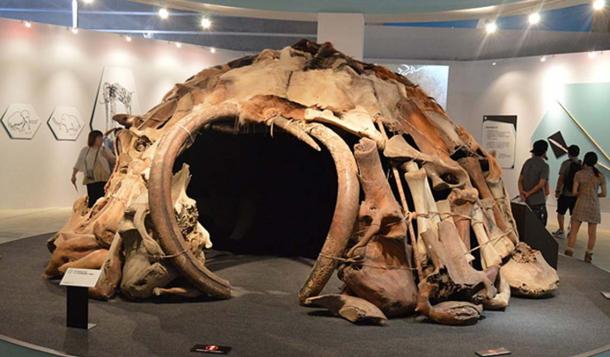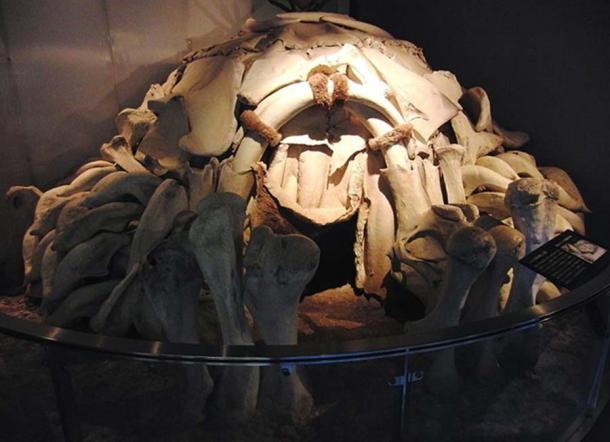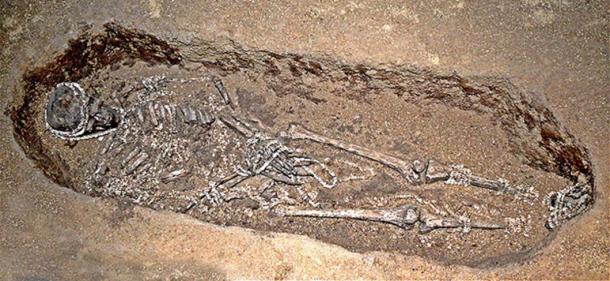Humans and mammoths coexisted in Europe for about 30,000 years. As a result, it makes sense that humans would have used mammoths and their remains for food and possibly for making clothing and even weapons. It appears, however, that they also used the bones and skin of mammoths to make domiciles. Recent discoveries in Russia demonstrate that Early Modern Humans in the late Paleolithic (and possibly Neanderthals) made these tents.

Hunting Mammoth
In the high arctic and in climates characterized by tundra and glaciers, wood tends to be scarce. As result, bone is often used in place of wood by cultures that live in areas such as the far north of Canada, Greenland, and Siberia. For example, bone harpoons have been found at sites in Ice Age Europe dating to the Magdalenian epoch (20,000-11,000 B.P.) when Europe was mostly tundra and glaciers.

Mammuthus primigenius “Hebior Mammoth specimen” bearing tool/butcher marks. (CC BY-SA 3.0)
During this period, Mammoths were present in much of Europe, including Eastern Europe in the Ukraine. Early Modern Humans appear to have been better at hunting mammoths than their Neanderthal forebears – who appear to have hunted mammoths much less often. Mammoths are found at kill sites associated with Homo Sapiens much more often than those associated with Neanderthals. One reason for this might be that Neanderthals did not use range weapons and probably wrestled their prey to the ground with knives and spears whereas humans used more long-ranged weapons. This would have made it easier and less dangerous to hunt a mammoth for Early Modern Humans than for Neanderthals. Semi-domesticated wolf-dogs may have also helped in hunting down and distracting the mammoth while the human hunters went in for the kill.

Mammal display in the Royal BC Museum in Victoria (Canada). (CC BY-SA 2.0)
Mammoth Use
Unlike Neanderthals, early modern Homo Sapiens appear to have hunted mammoths so often that they made dwellings out of their bones and skin. In the Ukraine, in the village of Mezhyric in 1965, some farmers came across a prehistoric site dating to 15,000 B.P. which turned out to contain numerous mammoth bones including skulls and tusks. From the arrangements of the bones and tusks, scientists determined that they were probably used as part of the dwelling.

“Mammoth House” as shown at the “Frozon Woolly Mammoth Yuka Exhibit” in Yokoyama, Japan in Summer 2013. (CC BY-SA 3.0)
Another site dating to 44,000 B.P. has also recently been found, which also contains mammoth tusks and skulls. It was found in Molodova in the eastern Ukraine and it consisted of 25 hearths surrounded by mammoth bones. The age of the site suggests that it was made by the Neanderthals, though this is not certain. An abundance of mammoth bones is after all something more associated with Homo Sapiens and 44,000 B.P. is within the margin of error for when humans first arrived in Europe. The older site could thus be the earliest evidence of Homo Sapiens in Europe, though we do only have one other instance of humans making mammoth bone tents 30,000 years later.
- Neanderthals cleared of herding mammoth over cliff edge
- Could Discovery of Mammoth Blood Lead to Revival of Species?
- The Peculiar Narrative of the Red Lady of Paviland, A Man from Paleolithic Wales
Why Undertake the Mammoth Task of Tent Building?
One thing that makes mammoth bone tents seem odd is that mammoths were difficult to kill and they probably were not the most common animals, though they were likely not uncommon during the Pleistocene. These two factors make it unlikely that mammoth bone tents were commonly used to make simple temporary shelters, even if they were portable. It is true that the population was much smaller in Europe during the Paleolithic, being not much more than a million across the entire continent, and most likely less. This, however, does not take away from the fact that mammoths were difficult to kill and probably less in number than humans.

Dwelling made from Mammoth Bones (reconstruction). (CC BY-SA 3.0)
It is possible, as a result of these factors, that the mammoth bone tents had some sort of special function, for example, they may have been used for ceremonial or religious purposes. They may also have been used to indicate the status of the owners. Hunter-gatherer societies do not usually have inherited status but they do have ascribed status. A man may not be born with high status, but through a life time of impressive feats in battle, hunting, or perhaps as a shaman, he could gain status. There is also evidence from Paleolithic sites of graves being made with special goods such as tools, flowers, or carvings. These special grave goods imply a difference in status for the people buried in such graves.
It is thus likely that there were status differences in Paleolithic societies, though based on ethnographic comparison with modern hunter-gatherers, this status probably had to be earned over the lifetime of an individual rather than being something that a person was born with.

Man buried with ivory bead grave goods in an Upper Paleolithic burial in Sunghir (Sungir), Russia. The site is approximately 28 000 to 30 000 years old. (Public Domain)
Based on these findings and possibilities for Paleolithic societies, it is possible that the mammoth bone tents may have belonged either to people of high status such as elite warriors, chieftains, or shamans, or the mammoth bone tents may have been places of great ritual significance such as a site for performing magical or religious rites.
Whatever the nature of the mammoth bone tents, it shows that pre-historic humans were quite intelligent and not the brutish cavemen of popular culture.
Top Image: Cro Magnon diorama showing a mammoth bone shelter. Source: Wally Gobetz/CC BY NC ND 2.0
By Caleb Strom